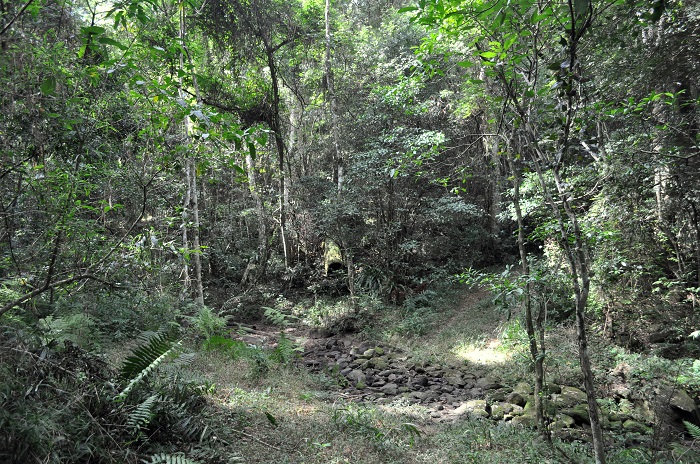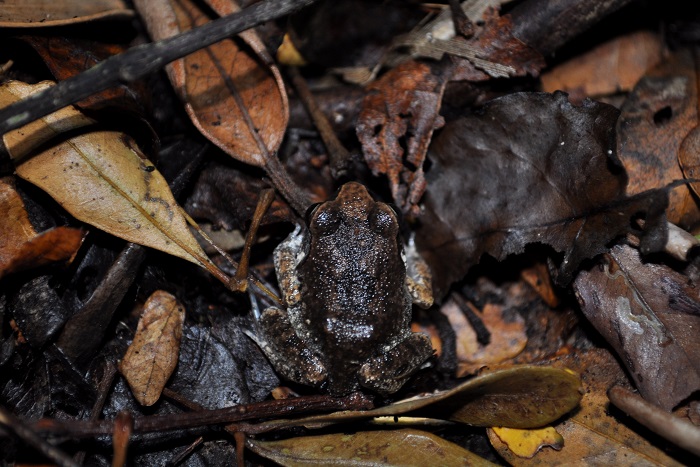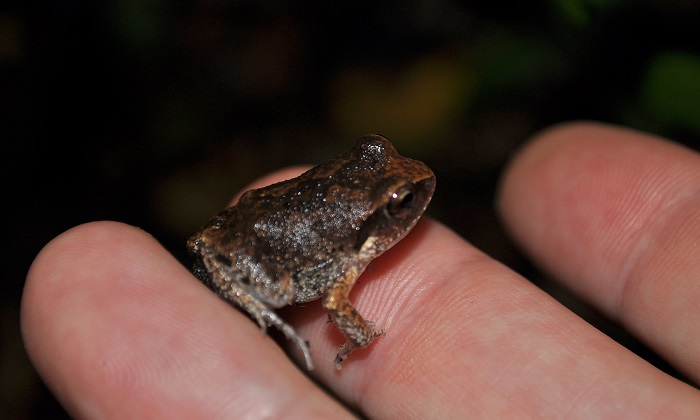Cover photo by M. Douglas.
Find the Bush Squeaker in the FBIS database (Freshwater Biodiversity Information System) here.
Family Arthroleptidae
Identification
The Bush Squeaker is a small species attaining a length of 25mm in females and 22mm in males. The colour pattern is variable, consisting mostly of different shades of brown. An hourglass pattern is commonly, but not always, visible on the back, and a pale vertebral stripe is sometimes also present. In contrast to the Shovel-footed Squeaker, the inner metatarsal tubercle is inconspicuous, rounded, and less than half the size of the inner toe.

Dlinza Forest, KwaZulu-Natal
Photo by Mark Liptrot
Habitat
The Bush Squeaker is a forest species, but it is also found in adjacent thickets and grassland with dense cover and accumulated leaf litter. These frogs are common where they occur and are frequently resident in gardens and in alien tree plantations. Annual rainfall within the distribution range is 500–750 mm, and falls in summer.

Photo by Ryan Tippett
Behaviour
Breeding takes place during spring and summer, with calling commencing immediately after rain (Channing 2001). In wet weather, males may be heard calling throughout the day and night from concealed positions in leaf litter. Clutches of 11–30 eggs are laid in damp leaf litter and develop directly into froglets which hatch and leave the nest after approximately four weeks (Wager 1986).

Durban, KwaZulu-Natal
Photo by Tyrone Ping
Food items consumed by the Bush Squeaker include woodlice and other crustaceans, beetles, and, probably, other small insects that live in the leaf litter (Wager 1986). Predators of A. wahlbergi have not been recorded.
Status and Conservation
Although the Bush Squeaker is not classified as threatened, in places its habitat is under pressure from housing development and the clearing of bush for agriculture. More detailed distribution information is needed to evaluate the species’ local conservation status. Where only small-scale disturbances occur, these frogs can recolonise gardens and similar areas of lush vegetation.

Mabibi, iSimangaliso Wetland Park, KwaZulu-Natal
Photo by Ryan Tippett
Distribution
The Bush Squeaker is endemic to the east coast of South Africa, from just south of Port St Johns (3129CD) northward to the Mozambique border (2632DD). In KwaZulu-Natal, its range extends inland to altitudes of c.1000 m in the mist belt, where it is particularly common.

Although adults are difficult to find, the distinctive, loud advertisement call is a reliable means of identification, and the atlas distribution data are therefore reasonably comprehensive and reliable.

Mabibi, iSimangaliso Wetland Park, KwaZulu-Natal
Photo by Ryan Tippett
Further Resources
The use of photographs by M. Douglas, Mark Liptrot, and Tyrone Ping is acknowledged. Other photographs by Ryan Tippett.
Bush Squeaker Arthroleptis wahlbergi Smith, 1849
Other Common Names: Boskikker (Afrikaans).
Recommended citation format: Channing, A; Tippett, RM. (2025). Bush Squeaker Arthroleptis wahlbergi . Biodiversity and Development Institute, Cape Town. Available online at https://thebdi.org/2021/11/15/bush-squeaker-arthroleptis-wahlbergi/
This species text has been updated and expanded from the text in the
2004 frog atlas: Channing, A. (2004). Bush Squeaker Arthroleptis wahlbergi. In Minter LR
et al 2004.
References:
Minter, LR; Burger, M; Harrison, JA; Braack, HH; Bishop, PJ; Kloepfer, D. (Editors). (2004). Atlas and Red Data Book of the Frogs of South Africa, Lesotho and Swaziland. Smithsonian Institution, Washington, and Avian Demography
Unit, Cape Town.
Carruthers, V; du Preez, L. (2017). Frogs of southern Africa: A Complete Guide. Struik Nature, Cape Town.
Channing, A. (2001) Amphibians of Central and Southern Africa. Protea Book House, Pretoria
Claus, B; Claus, R. (2002). Common Amphibians and Reptiles of Botswana. Gamsberg Macmillan, Windhoek.

